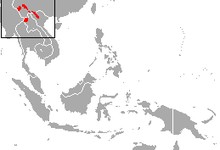Black crested gibbon
| Black crested gibbon | |
|---|---|
 |
|
| Scientific classification | |
| Kingdom: | Animalia |
| Phylum: | Chordata |
| Class: | Mammalia |
| Order: | Primates |
| Superfamily: | Hominoidea |
| Family: | Hylobatidae |
| Genus: | Nomascus |
| Species: | N. concolor |
| Binomial name | |
|
Nomascus concolor (Harlan, 1826) |
|
| Subspecies | |
 |
|
| Black crested gibbon range | |
| Synonyms | |
|
Hylobates concolor |
|
Hylobates concolor
The black crested gibbon (Nomascus concolor) is an endangered species of gibbon found in China, Laos, and northern Vietnam, with four subspecies.
The taxonomy of the species is confused. Previously grouped in the Hylobates genus, currently four subspecies are recognised.
The length from the head to the end of body is 43–54 cm (17–21 in) and it weighs from 6.9 to 10 kg (15 to 22 lb). The species exhibits sexual dichromatism, the male is almost completely black, but sometimes with white or buff cheeks, while the female is a golden or buff colour with variable black patches, including a black streak on the head.
Gibbons are forest dwellers and are well known for their habit of swinging between the branches of the rainforest on their long arms, a method of locomotion known as brachiation. Gibbons are also adept, however, at walking upright, both on the ground and in the trees. Black crested gibbons live in small family groups consisting of a monogamous male and female and their offspring; occasionally groups reportedly may contain additional mature females. These apes are predominantly arboreal and the group forages and sleeps amongst the trees. Led by the female, the breeding pair partakes in vigorous bouts of singing in the morning, which hauntingly echo through the forest. These ‘duets' are believed to be essential in pair bond formation and reinforcement, and also serve to advertise the presence of the group within the territory. A single young is born every two to three years and the infant is usually weaned once it reaches two years old;
Black crested gibbons feed preferentially on ripe, sugar-rich fruit, such as figs, but occasionally consume vitamin-rich leaf buds, and rarely eat animals.
Black-crested gibbons live arboreally in small groups, most of which consist of a pair of adults, one male and one female, and their offspring. It has been observed that some groups consist of one adult male living with two to four females and their offspring. The group could potentially include one infant, one juvenile, one adolescent, and one sub adult. Groups have been found to be territorial, like other species of gibbons. Territories are limited by the availability of the male for territory defense. Thus, group and territory size would be limited. With a large group, territory defense would not be favored by kin selection due to the group consisting of less-closely related individuals. Though the research is not explicit, there can be some assumptions made about altruism within groups. Since the majority of groups are living in monogamous relationships with both males and females displaying aggression when another individual enters, it is likely that kin selection plays a major role in determining behavior of the group. Kin recognition is thought to be favored for maternal-offspring relationships. This is largely due to primates’ uncertainty over paternity, even in pair-bonding species due to female promiscuity. Social behaviors within groups will evolve according to Hamilton’s rule.
...
Wikipedia

